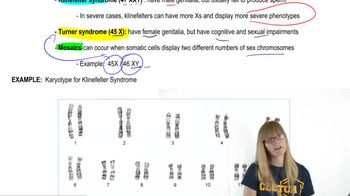Table of contents
- 1. Introduction to Genetics51m
- 2. Mendel's Laws of Inheritance3h 37m
- 3. Extensions to Mendelian Inheritance2h 41m
- 4. Genetic Mapping and Linkage2h 28m
- 5. Genetics of Bacteria and Viruses1h 21m
- 6. Chromosomal Variation1h 48m
- 7. DNA and Chromosome Structure56m
- 8. DNA Replication1h 10m
- 9. Mitosis and Meiosis1h 34m
- 10. Transcription1h 0m
- 11. Translation58m
- 12. Gene Regulation in Prokaryotes1h 19m
- 13. Gene Regulation in Eukaryotes44m
- 14. Genetic Control of Development44m
- 15. Genomes and Genomics1h 50m
- 16. Transposable Elements47m
- 17. Mutation, Repair, and Recombination1h 6m
- 18. Molecular Genetic Tools19m
- 19. Cancer Genetics29m
- 20. Quantitative Genetics1h 26m
- 21. Population Genetics50m
- 22. Evolutionary Genetics29m
3. Extensions to Mendelian Inheritance
Sex Chromosome
Problem 8
Textbook Question
What specific observations (evidence) support the conclusions about sex determination in Drosophila and humans?
 Verified step by step guidance
Verified step by step guidance1
Understand the concept of sex determination in Drosophila and humans: In Drosophila, sex is determined by the ratio of X chromosomes to sets of autosomes (X:A ratio), while in humans, sex is determined by the presence or absence of the Y chromosome (XX for female, XY for male).
Review the evidence for Drosophila: Studies have shown that a 1:1 X:A ratio results in a female fly, while a 0.5:1 X:A ratio results in a male fly. For example, flies with two X chromosomes and two sets of autosomes (2X:2A) develop as females, while flies with one X chromosome and two sets of autosomes (1X:2A) develop as males.
Examine the evidence for humans: The presence of the SRY gene (Sex-determining Region Y) on the Y chromosome is critical for male development. Individuals with an XY karyotype but a non-functional SRY gene develop as females, while individuals with an XX karyotype but a translocated SRY gene develop as males.
Compare the mechanisms: In Drosophila, the X:A ratio determines the activation of specific genes that regulate sex development, while in humans, the SRY gene triggers a cascade of events leading to male development. This highlights the difference in genetic mechanisms between the two species.
Summarize the observations: The key evidence includes the X:A ratio experiments in Drosophila and the role of the SRY gene in humans. These findings demonstrate that sex determination mechanisms are species-specific and rely on different genetic and chromosomal factors.
 Verified video answer for a similar problem:
Verified video answer for a similar problem:This video solution was recommended by our tutors as helpful for the problem above
Video duration:
3mPlay a video:
Was this helpful?
Key Concepts
Here are the essential concepts you must grasp in order to answer the question correctly.
Sex Chromosomes
Sex chromosomes are specialized chromosomes that determine the sex of an organism. In humans, the presence of XX typically indicates a female and XY indicates a male. In Drosophila, the sex determination system is based on the ratio of X chromosomes to autosomes, where a ratio of 1 (XX:AA) results in a female and a ratio of 0.5 (XY:AA) results in a male.
Recommended video:
Guided course

Human Sex Chromosomes
Genetic Evidence
Genetic evidence refers to data derived from the study of genes and their inheritance patterns. In Drosophila, mutations in sex-determining genes like 'tra' and 'dsx' provide insights into how sex is determined. Similarly, in humans, genetic disorders linked to sex chromosomes, such as Turner syndrome (XO) and Klinefelter syndrome (XXY), illustrate the role of sex chromosomes in determining sexual characteristics.
Recommended video:
Guided course

Descriptive Genetics
Environmental Influences
Environmental influences can affect sex determination in some species, although this is less common in Drosophila and humans. In certain reptiles, for example, temperature during incubation can determine the sex of the offspring. Understanding these influences helps to contextualize the genetic mechanisms of sex determination and highlights the complexity of biological systems.
Recommended video:
Guided course

Maternal Effect
Related Videos
Related Practice
Textbook Question
Contrast the XX/XY and XX/X0 modes of sex determination.
257244
views


